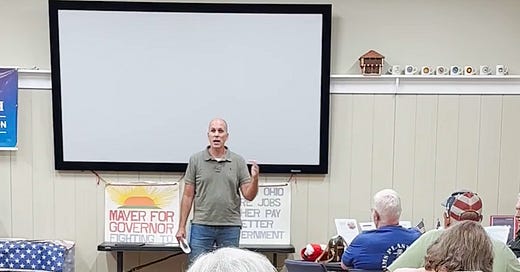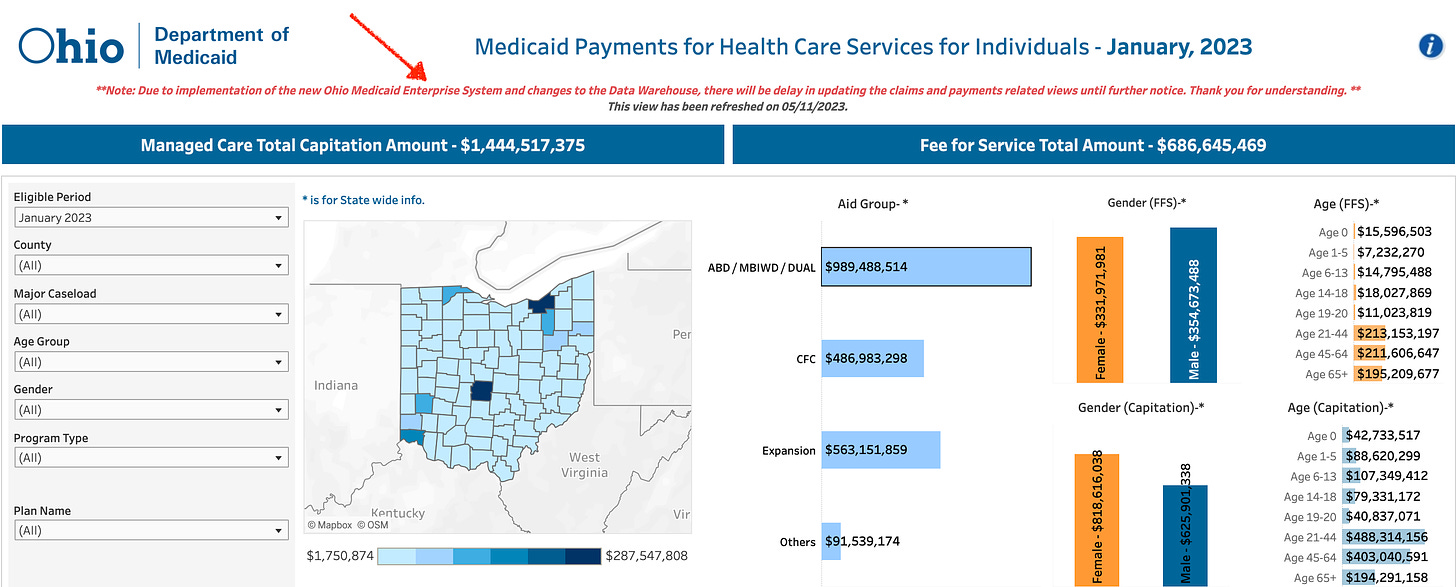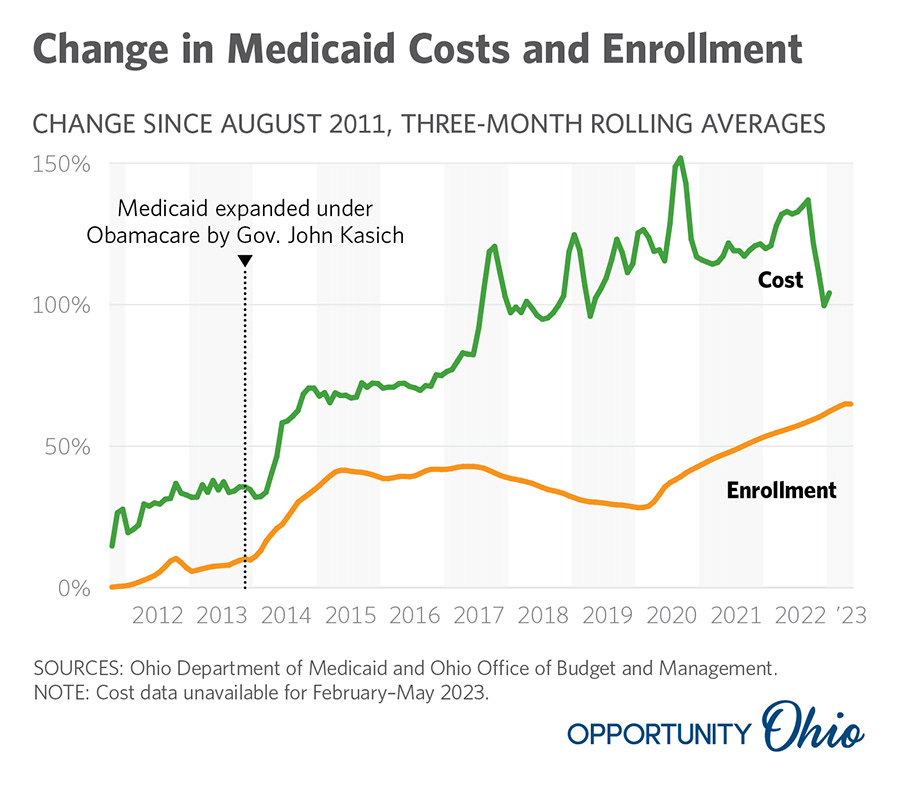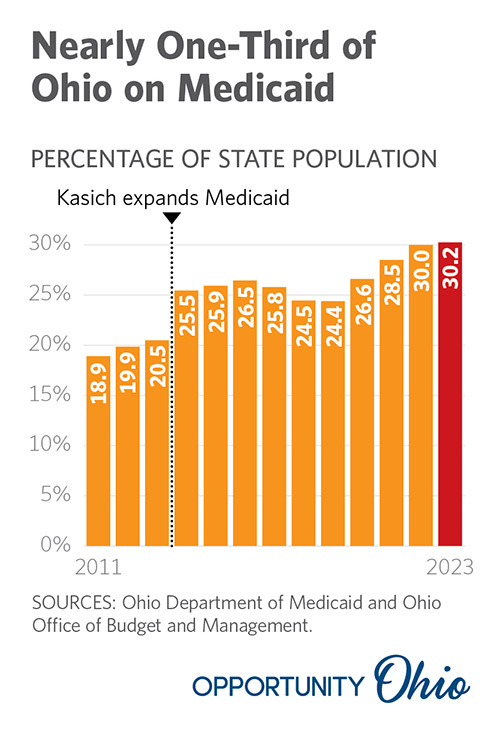I’ve recently heard from a couple of people that Jon Husted is utterly dismissive of the explosion in enrollment and costs of Ohio’s Medicaid program. He apparently likes to claim that, since the federal government is paying for 90% of the costs of Medicaid recipients enrolled as part of the Medicaid expansion under Obamacare, Ohio’s burden is no big deal. He’s not just dead wrong, but his position illustrates how little he truly understands basic economics and how things really work.
Let me explain.
First, contrary to his “no big deal” claim, Ohio’s Medicaid program has added over 1.1 million people since John Kasich expanded Medicaid under Obamacare to take advantage of the “free federal money.” In raw numbers, Ohio’s Medicaid program cost $17.3 billion in fiscal year 2012-2013 before Kasich rammed through the expansion in September 2013. We don’t have full-year numbers for fiscal year 2022-2023 yet (magically a system update is causing a six month delay in monthly cost data), but the cost in 2021-2022 was just over $29.0 billion. That $11.7 billion jump in costs equated to a 68% increase in just nine years, or more than 7.5% per year…even with the federal government paying 90% or more of the non-Ohio costs, Ohioans got stuck with a higher bill. Had Ohio been able to constrain enrollment and, therefore, costs, to just 2.5% per year, we would have spent $9.1 billion less, or nearly as much as the annual amount Ohio collects from the state income tax, which was $10.8 billion in FY2022-2023. Thus, Husted’s “no big deal” is in reality a really big deal, as in paving the way to getting rid of the state income tax kind of big deal.
This reality is exactly why I say we have to eliminate the Medicaid expansion at the same time we eliminate the state income tax. You simply cannot do the latter without first doing the former to gain total control over the state spending. For perspective, for the fiscal year that just ended, here are the top four General Revenue Fund spending categories:
Medicaid: $18,483,730,000
Primary and Secondary Education: $8,449,907,000
Justice and Public Service: $2,758,904,000
Higher Education: $2,447,551,000
Medicaid alone is nearly $5,000,000,000 MORE THAN the next three largest programs COMBINED.
Next, Husted’s position reflects plain economic ignorance when it comes to the federal government. We conservatives have long known and stated that there are no “free" lunches. The money must come from somewhere. In order to pay for Medicaid, the federal government runs a massive financial deficit ($1.2 TRILLION since October 2022). That annual deficit gets added to the growing national debt ($32.5 TRILLION). We are on the hook for that debt. As that debt climbs, the interest we must pay on that debt grows (nearing $1 TRILLION per year). That growth crowds out other spending priorities like strengthening our military and securing the border.
Finally, to pay for Medicaid, the federal government does what only it can do: it prints money. As it prints money, the value of the dollar declines as the market is flooded with more money. Because each dollar is worth less, prices rise. We call that inflation, which drives interest rates higher. Ohioans get hit with those higher rates when they buy a house, car, or use their credit cards. That means the item you buy on credit ends up costing you far more than it did before interest rates increased because of the money printed to cover the costs of Medicaid. Additionally, rarely do wages rise with inflation, so not only does it cost you more to buy goods and services on credit, but everyday items like groceries, gasoline, home goods, and vacations cost more, too, all the while you are functionally earning less. As Utah U.S. Senator Mike Lee recently noted, the average American family now spends $1,000 more every month because of inflation due to excessive federal spending for Medicaid and other programs.
Still sound like “no big deal” to you? After three gut punches from expanding Medicaid, I hope not.
I’d say this last element really is the last punch that hits you because of Medicaid expansion, but it actually isn’t. In reality, Medicaid expansion is growing dependency on government. That dependency undermines Ohio’s economy and will spread to other programs, as it is a learned behavior. Presently, there are 3.51 million Ohioans on Medicaid, so there is 3/4ths of a person on Medicaid for every one private sector worker. That level of dependency is simply unsustainable. Think Ohio’s Labor Force Participation Rate would be higher if Ohio wasn’t giving healthy, working age adults free health care? Of course, it would be. Another question: when does Husted think the expansion of Medicaid done under Obamacare should end? Never? It has been a decade already.
Don’t get me wrong. Many people will need a hand every now and again, which was the point of the original Medicaid program. The Obamacare expansion, however, is more about creating government dependency (and, therefore, support for Democrats who haven’t seen an entitlement program they didn’t expand endlessly). I believe the moral and fiscally responsible position is to preserve finite state (and federal) funds for the truly needy and to minimize the amount of money taken from Ohioans to pay for those programs. I also believe it is fundamentally wrong to overly tax Ohioans, cause interest rates to rise on them, and weaken their paychecks in order to give unending free healthcare to other Ohioans who can work or who have jobs. Husted apparently doesn’t believe that.
That is a big deal to me, which is why we will repeal Medicaid expansion when I’m governor.
P.S. The same analysis goes for ALL “free” federal funds like the CHIPS Act and other federal largess, which is why we need leaders who will push back on D.C. politicians writing checks they won’t cash, but you and I will pay for via greater debt obligations, higher interest rates, more inflation, and declining wages. This vicious cycle must end, but won't until we use the power of the Tenth Amendment to get power and money out of Washington, D.C., and back into the states so states can fully compete to see what policies work and what policies don’t work. I’ve long advocated for the decentralization of Medicaid and will do so vigorously using the full power of Ohio to wrest control from Washington.
Unlike Husted, my hand won’t be out as governor.
It will be up.











Share this post